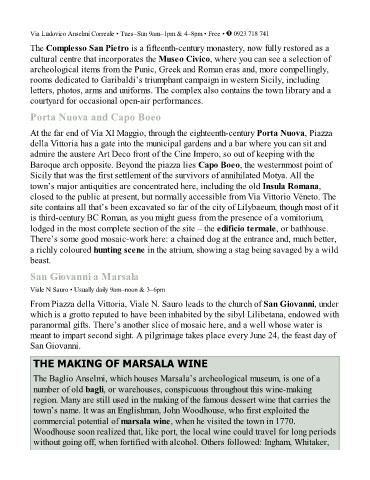Page 526 - The Rough Guide of Sicily
P. 526
Via Ludovico Anselmi Correale • Tues–Sun 9am–1pm & 4–8pm • Free • 0923 718 741
The Complesso San Pietro is a fifteenth-century monastery, now fully restored as a
cultural centre that incorporates the Museo Civico, where you can see a selection of
archeological items from the Punic, Greek and Roman eras and, more compellingly,
rooms dedicated to Garibaldi’s triumphant campaign in western Sicily, including
letters, photos, arms and uniforms. The complex also contains the town library and a
courtyard for occasional open-air performances.
Porta Nuova and Capo Boeo
At the far end of Via XI Maggio, through the eighteenth-century Porta Nuova, Piazza
della Vittoria has a gate into the municipal gardens and a bar where you can sit and
admire the austere Art Deco front of the Cine Impero, so out of keeping with the
Baroque arch opposite. Beyond the piazza lies Capo Boeo, the westernmost point of
Sicily that was the first settlement of the survivors of annihilated Motya. All the
town’s major antiquities are concentrated here, including the old Insula Romana,
closed to the public at present, but normally accessible from Via Vittorio Véneto. The
site contains all that’s been excavated so far of the city of Lilybaeum, though most of it
is third-century BC Roman, as you might guess from the presence of a vomitorium,
lodged in the most complete section of the site – the edificio termale, or bathhouse.
There’s some good mosaic-work here: a chained dog at the entrance and, much better,
a richly coloured hunting scene in the atrium, showing a stag being savaged by a wild
beast.
San Giovanni a Marsala
Viale N Sauro • Usually daily 9am–noon & 3–6pm
From Piazza della Vittoria, Viale N. Sauro leads to the church of San Giovanni, under
which is a grotto reputed to have been inhabited by the sibyl Lilibetana, endowed with
paranormal gifts. There’s another slice of mosaic here, and a well whose water is
meant to impart second sight. A pilgrimage takes place every June 24, the feast day of
San Giovanni.
THE MAKING OF MARSALA WINE
The Baglio Anselmi, which houses Marsala’s archeological museum, is one of a
number of old bagli, or warehouses, conspicuous throughout this wine-making
region. Many are still used in the making of the famous dessert wine that carries the
town’s name. It was an Englishman, John Woodhouse, who first exploited the
commercial potential of marsala wine, when he visited the town in 1770.
Woodhouse soon realized that, like port, the local wine could travel for long periods
without going off, when fortified with alcohol. Others followed: Ingham, Whitaker,

